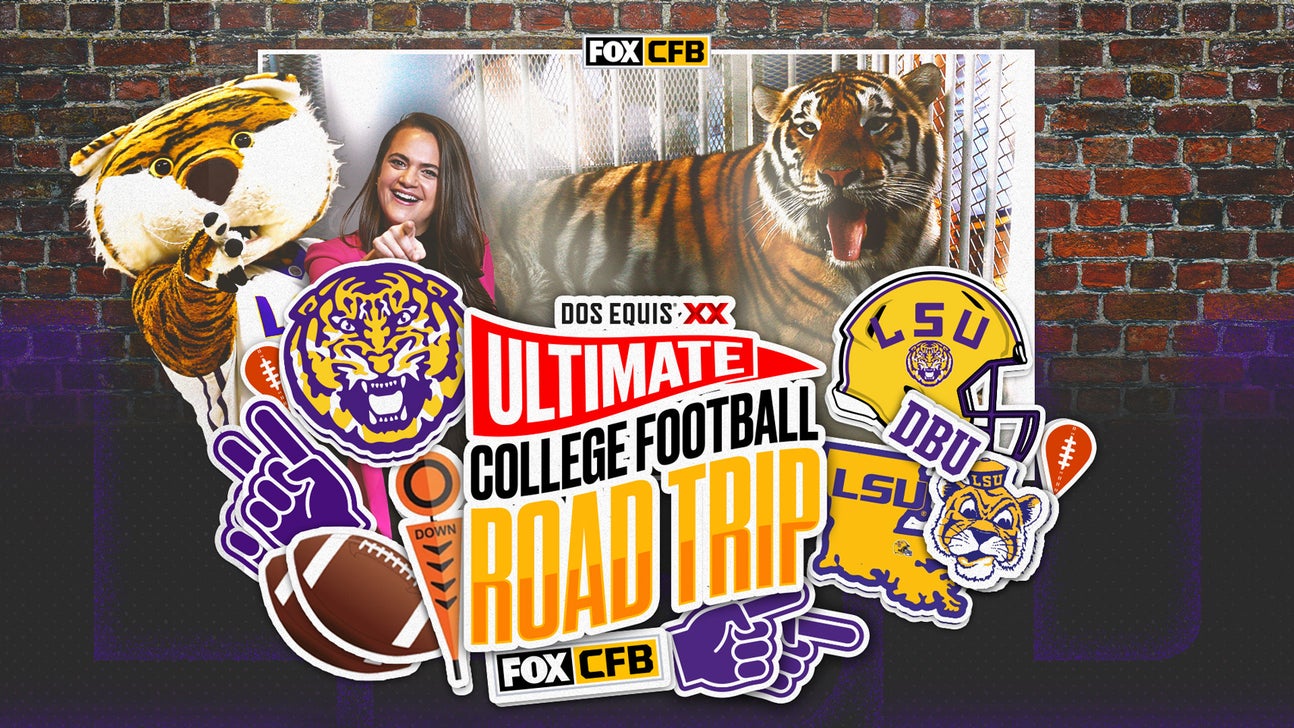
LSU: The best place for college football
By Charlotte Wilder
FOX Sports Columnist
BATON ROUGE, La. — According to Dr. David Baker, the head veterinarian at the LSU School of Veterinary Medicine, the tiger is the most depicted animal in the world. Which is to say there are more drawings, paintings, sculptures, tapestries — you name it — of tigers than any other animal.
I have been trying to Google this fact for an hour, and I can’t verify it, but I’m inclined to believe Baker. Tigers are everywhere. They are on T-shirts, they are on lamps, they are on ancient cave walls. There is something about tigers that has, for thousands of years, compelled humans to try to capture their essence.
After this week, I understand it. Because this week, I met Mike the Tiger at LSU. And today, after touring Tiger Stadium as part of the Dos Equis Ultimate College Football Road Trip, I also understand why LSU is the best place in the world to experience college football.
But first, Mike.
I didn’t just meet him: Baker opened a gate and led me into an enclosure that allowed me to get closer to the tiger than the public is usually allowed. While I interviewed Baker, Mike would periodically come up behind me and rub his face against the fence, like a house cat coming to say hello before sauntering off to find a sunny spot in the living room. I felt his fur touch my back.
Baker has a special relationship with Mike because Baker has been the vet in charge of tigers at LSU for more than 20 years. This current tiger is Mike VII, and Baker was responsible for the two previous Mikes before him.
There’s clearly trust between man and beast, which is what I suppose happens when you’ve raised two other tigers and been the person closest to Mike VII since the little cub arrived at LSU as an 11-month-old from a rescue facility.
Mikes IV, V and VI also came from rescue facilities. The last tiger LSU bought was Mike III in 1958, and the university no longer supports the for-profit breeding of tigers. They see the tradition and on-campus sanctuary as a way to provide relief for an animal who would otherwise be in illegal and possibly horrific conditions.
"The habitat was designed by an architect that specializes in animal enclosures, an LSU graduate, and it incorporated natural substrates, so [Mike] doesn't have to walk on concrete, and someplace where he can get out of the weather at any time of the day," Baker said. "It’s irregularly shaped, so the view is interesting looking out as well as looking in. Then there’s the water: Tigers and jaguars are natural swimmers and are never found in the wild away from water, so that was very important for him."

Mike the Tiger rests in his habitat, which was designed by an architect who specializes in animal enclosures. (Photo by John Korduner/Icon Sportswire via Getty Images)
LSU no longer brings Mike to games, either, and two veterinary students each year are allowed to work with Mike for two-year stints after completing four-month apprenticeships.
Not everyone thinks it’s great or ethical for a school to have a live tiger on its campus, but PETA has said LSU is "moving in the right direction" and is an example of how schools with live mascots should be treating their animals. Mike even received an animal-approved COVID vaccine; Baker gave the tiger the two required doses once LSU got off the waitlist for the specific, protein-based shot.
When I asked if I could pat Mike, I received a firm no, but Baker reached his hands through the chain-link fence and scratched Mike’s back as Mike "chuffed," which is a tiger’s version of purring. And it turns out that being that close to a 410-pound, wild animal was one of the more moving experiences of my life. It felt spiritual in a way that I am struggling to describe but that makes it absolutely clear why humans have made art about tigers for so long.
Mike is so stunningly beautiful and strong that he takes your breath away. He looks enough like a house cat to feel familiar (and it took everything I had not to reach in and pet him) but is so supersized that he was alien. I was near something so primal that it almost shouldn’t have been able to exist in physical form.
Mike is huge, yet he moves with grace and a quiet power when he’s happy. Which he usually is. He gives off the vibe, however, that at any given moment, there is the possibility of an explosion simmering just below his striped coat.
It’s for these many reasons that 56 United States colleges or universities in the United States have a tiger mascot. A tiger is everything a winning sports team wants to be: unpredictable and intimidating, with the potential to absolutely demolish an enemy at the blow of a whistle.
But only LSU has a real tiger. Which feels very, well, LSU-y.
Earlier in the day, before I met Mike, I toured Tiger Stadium. Both the stadium and Mike are slightly spooky and majestic in the same way. The stadium even has old dorms built into it that no one has been in — let alone lived in — for years.
During the Great Depression, the college had to find a way to house students at low cost and also wanted to increase the number of seats in Tiger Stadium. The university had the funds to add dorms but none to expand the stadium, so they built the dorms into the stadium and stuck seats on top.
The entire structure is very sparse. Every concrete column, every steel beam and every screw is visible throughout the entire 102,000-seat stadium. I got chills walking onto the empty field knowing that a full crowd is capable of such noise that it registers on a seismograph.
Both LSU and Mike don’t have to try hard to be tough, don’t have to try hard to be intimidating, don't have to try hard to be anything other than they are: slightly haunted, almost indecipherable and innately sure of themselves. This place is gothic in the true sense of the word — a little otherworldly, like an empty, old cathedral.
There is a reason these are the words of the hype video that plays before every game:
"There is a pantheon of concrete and steel. It is a city that rises quietly in the delta alongside the father of waters. It is the humidity of autumn evenings that great stately oaks and broad magnolias. It is haunted and it is loud. It is Halloween night and cannon blasts. It is a Louisiana gum bowl of humidity that cheers its tigers to victory and destroys the dreams of appending foes. Chance of rain is never. It is the cathedral of college football and worship happens here when the sun finds its hold in the western sky. It is a field of glory, but much more than that. It is a sacred place."

Tiger Stadium is an awe-inspiring site … and an intimidating place for LSU's opponents. (Photo by Steve Franz/Louisiana State University/Getty Images)
There is a reason this team plays in a place nicknamed Death Valley. There is a reason for the quiet confidence of this campus, of this whole city. Walking through the skeleton-like stadium, I felt that it has forgotten more secrets than I’ll ever know.
But I do know this: I haven’t even been to a game yet, and I’m convinced this is the best place in college football. There is nowhere as inherently cool as LSU. There is only one Mike, but there’s a legacy of many.
There is nowhere more alive and more ghostly at the same time.
Charlotte Wilder is a general columnist and cohost of "The People's Sports Podcast" for FOX Sports. She's honored to represent the constantly neglected Boston area in sports media, loves talking to sports fans about their feelings and is happiest eating a hotdog in a ballpark or nachos in a stadium. Follow her on Twitter @TheWilderThings.










